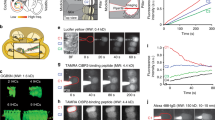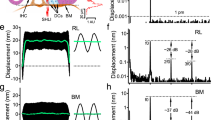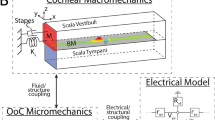Abstract
Hair cells in the mammalian cochlea transduce mechanical stimuli into electrical signals leading to excitation of auditory nerve fibres1. Because of their important role in hearing, these cells are a possible site for the loss of cochlear sensitivity that follows acoustic overstimulation2,3. We have recorded from inner and outer hair cells (IHC, OHC) in the guinea pig cochlea during and after exposure to intense tones. Our results show functional changes in the hair cells that may explain the origin of noise-induced hearing loss. Both populations of hair cells show a reduction in amplitude and an increase in the symmetry of their acoustically evoked receptor potentials. In addition, the OHCs also suffer a sustained depolarization of the membrane potential. Significantly, the membrane and receptor potentials of the OHCs recover in parallel with cochlear sensitivity as measured by the IHC receptor potential amplitude and the auditory nerve threshold. Current theories of acoustic transduction4–6 suggest that the mechanical input to IHCs may be regulated by the OHCs. Consequently, the modified function of OHCs after acoustic overstimulation may determine the extent of the hearing loss following loud sound.
This is a preview of subscription content, access via your institution
Access options
Subscribe to this journal
Receive 51 print issues and online access
$199.00 per year
only $3.90 per issue
Buy this article
- Purchase on Springer Link
- Instant access to full article PDF
Prices may be subject to local taxes which are calculated during checkout
Similar content being viewed by others
References
Russell, I. J. & Sellick, P. M. J. Physiol., Lond. 284, 261–290 (1978).
Robertson, D. & Johnstone, B. M. Hearing Res. 3, 167–179 (1980).
Cody, A. R. & Johnstone, B. M. J. acoust. Soc. Am. 70, 707–711 (1981).
Weiss, T. F. Hearing Res. 7, 353–360 (1982).
Neely, S. T. & Kim, D. O. Hearing Res. 9, 123–130 (1983).
Russell, I. J. & Ashmore, J. F. Hearing—Physiological Basis and Psychophysics (eds Klinke, R. & Hartmann, R.) (Springer, Berlin, 1984).
Russell, I. J. & Sellick, P. M. J. Physiol., Lond. 338, 179–206 (1083).
Davis, H. Laryngoscope 68, 359–382 (1958).
Dallos, P., Billone, M. C., Durrant, J. D., Wang, C. Y. & Raynor, S. Science 177, 356–358 (1972).
Russell, I. J. Nature 301, 334–336 (1983).
Lim, D. J. J. acoust. Soc. Am. 67, 1686–1695 (1980).
Brownell, W. E., Bader, C. R., Bertrand, D. & de Ribaupierre, Y. Science 227, 194–196 (1984).
Flock, A. Hearing—Physiological Basis and Psychophysics (eds Klinke, R. & Hartmann, R.) (Springer, Berlin, 1984).
Tilney, L. G., Saunders, J. C., Egelman, E. & De Rosier, D. J. Hearing Res. 7, 181–197 (1982).
Miller, J., Canlon, B., Flock, A. & Borg, E. Assoc. Res. Otoloaryngol., 50 (1985).
Flock, A. Assoc. Res. Otolaryngol., 175 (1985).
Author information
Authors and Affiliations
Rights and permissions
About this article
Cite this article
Cody, A., Russell, I. Outer hair cells in the mammalian cochlea and noise-induced hearing loss. Nature 315, 662–665 (1985). https://doi.org/10.1038/315662a0
Received:
Accepted:
Issue Date:
DOI: https://doi.org/10.1038/315662a0
This article is cited by
-
Effect of Selective Carboplatin-Induced Inner Hair Cell Loss on Temporal Integration in Chinchillas
Journal of the Association for Research in Otolaryngology (2022)
-
Gap Detection Deficits in Chinchillas with Selective Carboplatin-Induced Inner Hair Cell Loss
Journal of the Association for Research in Otolaryngology (2020)
-
Blast-induced cochlear synaptopathy in chinchillas
Scientific Reports (2018)
-
Amplification mode differs along the length of the mouse cochlea as revealed by connexin 26 deletion from specific gap junctions
Scientific Reports (2017)
-
Selective Inner Hair Cell Dysfunction in Chinchillas Impairs Hearing-in-Noise in the Absence of Outer Hair Cell Loss
Journal of the Association for Research in Otolaryngology (2016)
Comments
By submitting a comment you agree to abide by our Terms and Community Guidelines. If you find something abusive or that does not comply with our terms or guidelines please flag it as inappropriate.



